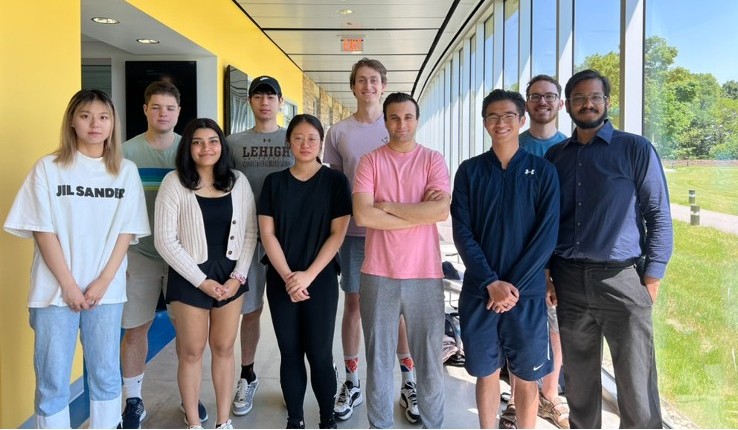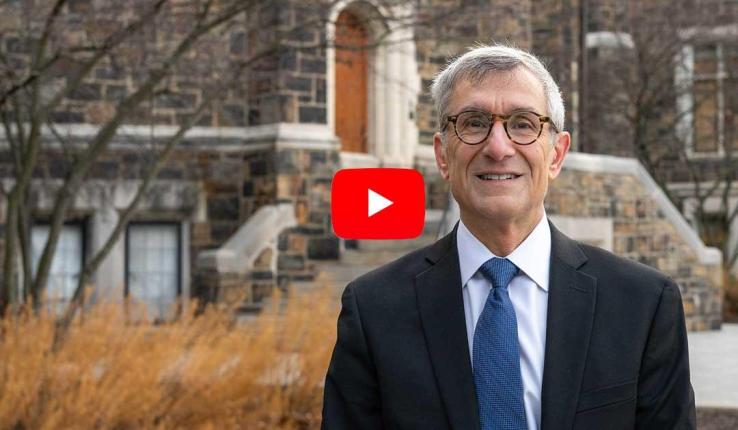Pennsylvania is home to America’s oldest stock market exchange, the Philadelphia Stock Exchange (now the Nasdaq PHLX), which first opened in 1790. In that day, the state was known primarily for its industrial production, including steel, but now Pennsylvania is home to the headquarters of a range of businesses across all sectors.
Nandu Nayar, chair of the Perella department of finance at Lehigh’s College of Business, ideated a project for its Master's of Financial Engineering (MFE) program that might cater to innovation within the state, while giving students hands-on learning opportunities. “I thought, ‘Is there a way to quantify what the state has done in terms of actual commercial activity?’” says Nayar.
Enter: The PA-100 Index.
A group of more than a dozen students in the MFE program developed the PA-100 Index—an equity index representing the 100 largest public companies headquartered in Pennsylvania by market capitalization—entirely from scratch. That’s no small feat.
Ramos Wu '21, a second-year MFE student, has been involved with the PA-100 Index from the start. In addition to the project’s logistics (creating the soon-to-be-live website, fitting it to university standards, gathering data, constructing the index to industry standards and more), Wu found himself leading his cohort toward a tangible goal. “You get to show potential employers that you have done real work instead of just your experience in the classroom,” says Wu.
As Wu progressed in the MFE program, he passed the torch of leadership for the PA-100 Index to Wasti Khan '22, who started in the program in August 2022.
Khan began working on the PA-100 Index during his time as a fellow at Lehigh’s Mountaintop Summer Experience after hearing about it from MFE Program Manager Patrick Zoro.
“Summer was just about learning with the team what indices are, how they’re made, and how we can make our own,” says Khan. For the actual development of the index, “We use open source APIs, collect daily data, then process it to calculate the market caps every day.” That’s in addition to calculating index math behind the scenes, checking for errors, coding and leading a team, Khan says.
Nayar recognizes the benefits of students taking something on for themselves. “Learning flexibility, learning the resilience, I think is the key takeaway from these project-learning experiences, and that’s something Patrick Zoro has tried to infuse in the MFE program.” Nayar adds, “Basically, how do we get students to handle real-world complexities beyond just the academic, textbook version of a project? That’s where these projects, with an actual deliverable, can really enhance the learning experience for our students.”
“We will market the index to companies that are included, and we’ll reach out to various entities within Pennsylvania so they can use it as a means of promoting the state’s economy,” says Zoro about the prospects of the index. “We’ll also target the [Pennsylvania] Chamber of Commerce, the state legislature and beyond. The potential is massive.”
Given that students eventually graduate from the MFE program, Zoro recognizes its future will take a new shape, saying, “New students will take on the mantle to manage it, make it better, make it bigger, enhance the marketing and reach of the index and maybe create other indices as well.”
That’s not to say students are entirely on their own. The corporate sponsor for the PA-100 Index project is Lehigh alum Alex Matturri ’80, retired CEO of S&P Dow Jones Indices, board member of CBOE Global Markets and The Index Standard.
“Alex has been an absolutely phenomenal resource because he was in the industry at the highest level,” Khan says.
Matturri recognizes how in-depth the PA-100 Index project is. “They’re going beyond what a lot of schools would’ve done, which is just designing an index. They’re actually building the calculation platform and working on the website, which is a much more elaborate project.”
The first index of this kind, the Dow Jones Railroad Average (now called the Dow Jones Transportation Average), was published in 1884 in a precursor to The Wall Street Journal as a way to explain to readers what was going on in the market. Today, there’s a massive indexing industry serving a similar core purpose.
As for the PA-100 Index, “It really ties back to the growth of Pennsylvania,” Matturri says. “There’s a nice tie-in to the local economy.”
Lehigh’s Library and Technology Services Group provided help to make the technology tamper proof, particularly LTS Assistant Director Amanda Caton.
Due to the PA-100 Index project’s multifaceted nature (math, data science, leadership, and the like), the experience gives students an opportunity to explore various paths. Wu has accepted an offer to be an associate in a tech consulting company. “I am also setting myself up to learn different things and get different certifications to be a wealth manager in the future,” he says.
For Khan, the PA-100 Index project put him on a path toward index construction. “It’s something I’m interested in and have experience in,” he says, noting what started as an undergraduate engineering school major has transformed into something more rewarding for him.
The project is bound to evolve with future MFE groups, including building in automation, marketing the index, and more. “Hopefully,” Matturri says, “This is a living, breathing project that will continue into the future.”
Story by Rachel Curry





